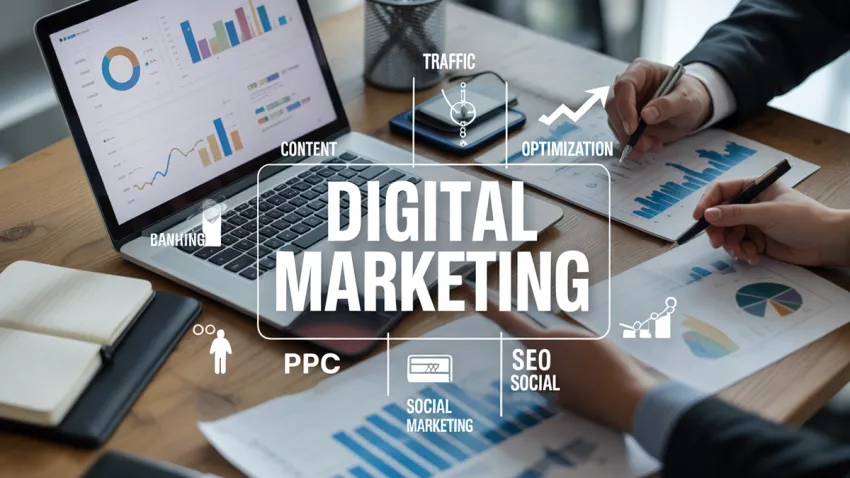The Main Benefits of Digital Marketing

What Is Digital Marketing and How Does It Work?
In today’s competitive world, small and medium-sized businesses often face the same challenge: how to become visible, attract customers, and stay competitive. Traditional advertising methods (print media, billboards, television) are not only expensive but also often fail to deliver targeted results.
This is where Digital Marketing becomes a real game-changer. Digital marketing is no longer a tool reserved only for large corporations - it has become the driving force behind the growth of small and medium-sized businesses. With the right strategy, it’s possible not only to attract new customers but also to build long-term relationships and establish a trusted brand.
A digital marketing strategy allows businesses to leverage multiple digital channels - such as social media, pay-per-click advertising, search engine optimization and email marketing - to connect with existing customers and engage individuals who are genuinely interested in their products or services.
What Are the Fundamentals of Digital Marketing?
Digital marketing encompasses all marketing methods carried out through electronic devices that in some way utilize a computer. This also includes online marketing efforts conducted via the internet.
When implementing digital marketing, businesses can use websites, search engines, blogs, social media, video, email and similar channels to reach their customers.
Unlike traditional marketing - which is static and often referred to as “one-way communication” - digital marketing is a constantly evolving, dynamic process. In other words, a customer cannot interact with a business through a billboard or print ad, whereas digital marketing enables two-way communication between a business and its current or potential customers.
Today, screen time is at an all-time high for most people. Digital marketing takes advantage of this reality by promoting products and services online. This way, businesses ensure their marketing efforts are more likely to reach customers by targeting them where they spend most of their time.
From startups to large enterprises, a multi-layered digital marketing approach can deliver significant commercial advantages. A successful digital marketing strategy typically involves a combination of methods such as online advertising, search engine optimization and marketing, social media marketing and management, content creation, and other tools.
The Difference Between B2B and B2C Digital Marketing
B2B (Business-to-Business) decisions usually involve the participation of multiple stakeholders, whereas B2C (Business-to-Consumer) purchases are often made by a single individual.
B2B clients typically have a longer decision-making process, which is why digital marketing should focus on building and nurturing relationships.
B2C purchases usually have a shorter cycle, requiring short-term and urgent messaging.
B2B transactions are more logic-driven and based on rational arguments, while B2C transactions are often influenced by emotions.
Fortunately, digital marketing is effective for both approaches. Whether you’re targeting businesses or consumers, digital marketing helps streamline the marketing process and deliver results.

Why Is Digital Marketing Important?
Digital marketing is important because it creates a level playing field. Small businesses can reach the same audiences as large corporations - without the need for massive budgets.
It helps brands build awareness, create meaningful connections with customers, and generate tangible results - whether through lead generation, sales, or community growth.
Digital marketing also enables businesses to engage with customers at various stages of the buying process.
For example, you can launch a paid advertising campaign and then continue the conversation with leads after they’ve made a purchase. This could be as simple as saying thank you, or using the opportunity to suggest related products.
What Are the Best Practices in Digital Marketing?
Strong digital marketing is built on consistency, mobile optimization, data-driven improvements, and a focus on user experience. Here are four best practices to follow:
Consistency
Maintain a unified brand voice, visuals, and messaging across all platforms - whether it’s your website, email campaigns, or social media. Consistency builds trust, reinforces your brand values, and strengthens recognition.
Mobile Optimization
Since most users browse content on mobile devices, your website and ads must be designed for smaller screens. Responsive design, fast loading speeds, and simple navigation are essential - not only for user satisfaction but also for better search engine rankings.
Testing and Optimization
Digital marketing is not static. Test headlines, visuals, CTAs, and audience segments to determine what works best. Use performance data to refine your strategy and steadily improve ROI through continuous optimization.
Focusing on User Experience (UX)
A smooth and intuitive user experience significantly increases conversion rates. Key elements of good UX include clear navigation, engaging content, fast site performance, and streamlined checkout processes. Strong UX not only drives results but also encourages repeat visits and long-term customer loyalty.



